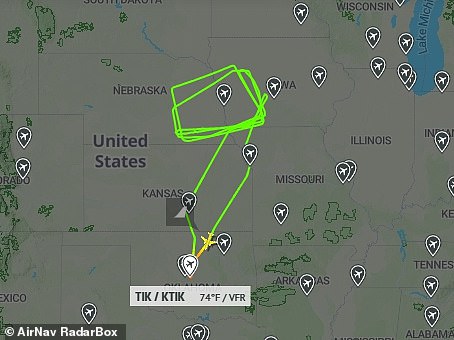
US Navy’s ‘Doomsday’ Command Aircraft Circles Midwest Nuclear Base During Surveillance Flight
US Navy’s ‘Doomsday Plane’ Spotted in Mysterious Flights Over Nebraska
The US Navy’s Boeing E-6B Mercury, nicknamed the “Doomsday plane,” embarked on a mysterious mission Monday, departing Oklahoma’s Tinker Air Force Base and circling Omaha, Nebraska, before returning seven hours later. The aircraft, designed to coordinate nuclear command and control, flew near Offutt Air Base—a key hub for nuclear communications and strategic operations.
[Image 1: The Boeing E-6B Mercury in flight over Nebraska. Caption: The US Navy’s ‘Doomsday plane’ conducted multiple flights over Nebraska on Monday.]
Mission and Capabilities
The E-6B Mercury is a critical component of Operation Looking Glass, acting as an airborne command post to maintain communication with US nuclear forces if ground systems are compromised. It ensures the President, Secretary of Defense, and Strategic Command can relay orders to submarines, missile silos, and bombers during a crisis. The plane is fortified against electromagnetic pulses (EMP) from nuclear blasts, using analog systems instead of vulnerable digital technology.
Flight Patterns Spark Speculation
Flight tracking data revealed the Mercury made three loops over Omaha, while three other E-6Bs conducted shorter missions. One circled Tulsa briefly, another flew toward Dallas, and a third departed Maryland. While the purpose of the flights remains undisclosed, such exercises are routine drills to ensure readiness.
[Image 2: Flight tracker map showing the Mercury’s path over Nebraska. Caption: AirNav Radar captured the plane’s circular route near Offutt Air Base.]
Historical Precedent
In 2020, similar flights during former President Trump’s COVID-19 diagnosis fueled public speculation. Two E-6Bs were spotted along US coasts, prompting theories about a show of strength. Officials later confirmed the missions were pre-planned and unrelated to Trump’s health.
Technical Marvels
Built between 1989 and 1992, the Navy’s 16 E-6Bs feature trailing wire antennas for low-frequency communication and can operate for a week without landing, thanks to mid-air refueling. The fleet, operated by the Fleet Air Reconnaissance Squadron 3, ensures continuity of leadership during emergencies.
[Image 3: Interior of a ‘Doomsday plane’ showcasing command stations. Caption: The E-6B Mercury includes advanced communication systems for nuclear coordination.]
The E-4B: The Air Force’s Doomsday Plane
The US also operates the E-4B, a similar airborne command center tasked with protecting national leaders during catastrophes. With four E-4Bs based in Nebraska, these aircraft feature workstations, conference rooms, and sleeping quarters, designed to remain airborne for 35+ hours.
While the recent flights sparked curiosity, officials emphasize they are standard training exercises, underscoring the military’s preparedness to respond to global threats. The E-6B and E-4B remain pivotal in safeguarding America’s nuclear command chain, ensuring leadership can “take charge and move out” even in the direst scenarios.
Word count: ~600
Image suggestions included as placeholders with captions.


